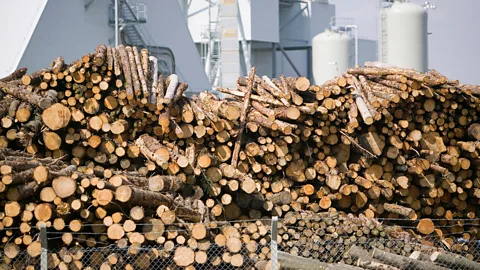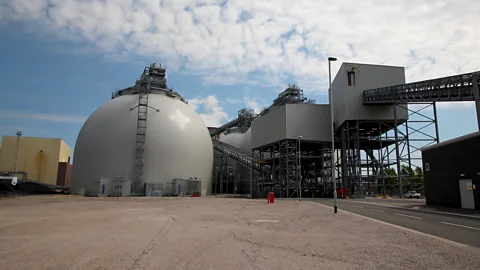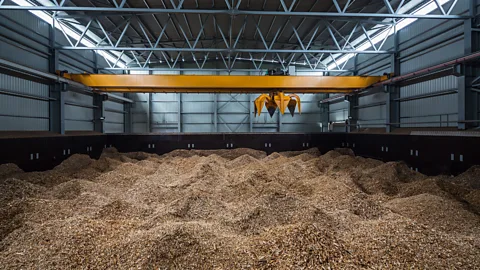The giant coal plant converting to green energy
 Chris Baraniuk
Chris BaraniukThe UK plans to end coal-fired electricity by 2025. But what happens to the massive plants left behind? One facility is pioneering an unusual idea: converting to green energy.
On the train to visit one of the last places in Britain that burns coal for electricity, I pass three solar farms soaking up sunshine. I also pass a coal plant called Eggborough that has all but ceased operations. No steam rises from its giant cooling towers. It will shut in September.
But the coal plant I’m visiting is different. It’s named Drax, after a local village, and is the largest power plant in Western Europe. By 2023, its owners plan to stop burning coal entirely. They hope that instead their plant will consume only natural gas and biomass – wood pellets crushed into powder.
The European Union has some key targets for reducing pollution in the coming decades and coal power plants have been earmarked for closure by many countries seeking to meet these objectives. In the UK, government plans mean coal-fired electricity generation will end by 2025.
A similar story is unfolding elsewhere in the world. Many nations, including the US, are moving away from coal as other energies become cheaper and as environmental regulations cool the market for this fossil fuel.
But this leaves a big question: what do we do with all of those old power stations?
You might also like:
For the past century, these facilities have been huge players in the world’s energy market. The plants have expensive connections to national grids – meaning that simply knocking them down might not be so smart. Many, including Drax’s management, are insisting that there is another way.
 Getty Images
Getty ImagesThe scale of Drax is immediately apparent. On either side of the huge buildings that house its boilers and turbines stand six beige cooling towers. White steam drifts skyward. In the middle of the complex stands a 259m-tall chimney. And at the back of the facility there is a huge pile of coal – but staff members tell me it is much smaller now than it once was.
Coal is left here until it is brought into the power station on conveyor belts, ground up and burnt at ferocious temperatures. The furnace heats up water, turning it into steam that rushes through a complex system of pipes and spins turbines at a steady 3,000 revolutions per minute. It’s an easy way of producing electricity. It’s also a dirty one.
Energy shift
This is a large part of why coal’s days here really are numbered. In April, Britain went for more than three full days without any coal power at all – a decline that has happened far more quickly than many expected. This trend has meant that since the start of 2018, the country has managed a total of 1,000 hours without coal energy, already topping last year’s tally.
“In 2012, coal-fired generation was 45% of the power mix,” says Matthew Gray at Carbon Tracker, a think tank. “Today it’s at a very low amount.”
From the perspective of a plant operator, though, replacing coal isn’t easy. That’s because biomass is a far less forgiving material than coal, says chief executive Andy Koss.
“It clogs things up,” says Koss, remembering how early experiments in moving the biomass on coal conveyors led to the pellets disintegrating and creating dust. The biomass also has to be kept dry at all times, unlike coal, lest it swell into a useless porridge-like mix. It’s even liable to burst into flames as it slowly oxidises so piles of it have to be constantly checked for temperature rises. Drax spent £700m on converting Drax and ensuring that the new biomass could be handled gently and along rain-safe pathways through the plant.
And the power station also has invested in four bulbous domes, each one 50 metres high, to store biomass in on site. Every day, 16 covered trains arrive and deposit more of the wood pellets to keep the plant’s supplies topped up. The wagons pass through a shed and open automatically, triggered by magnets, as they roll over a grate in the ground. The wood pellets spill down through the grate, deep into a cavern below before being taken to the domes for temporary storage.
 Chris Baraniuk
Chris BaraniukIn terms of biomass operations, “I would say it’s the largest in the world,” says Koss. At the time of my visit, Drax had two gigawatts of coal capacity and the same for biomass. It has now completed its fourth generating unit for biomass. The remaining two will eventually burn gas.
Drax has tried to rebrand itself as a poster boy for what can be done with an old coal plant – where there’s enough will and, indeed, money to pay for conversions. Many small coal facilities in the US have recently converted to burning gas – a cheaper kind of transition than biomass.
And Drax wants to build large batteries on site to store electricity for when the grid needs it most. There are other, similar projects around the world. A Canadian firm, Hydrostor, has designed schemes for turning old coal plants into compressed air batteries. The air can be released to force the plant’s turbines back into action whenever electricity is needed.
There are plenty of other ideas for reinventing former coal-burning facilities, too. In 2016, China announced it had plans to convert some of its coal plants to nuclear power stations – though there has not been much news about the proposals since. And Drax is far from the only coal-to-biomass project in the world, even if it is the largest.
Why is coal so polluting?
Coal produces a range of pollutants – notably carbon dioxide (CO2), a greenhouse gas. A lump of coal can contain between 60-80% carbon. The CO2 is produced when coal is burnt. Greenhouse gases build up in the earth’s atmosphere where they form a layer that traps heat, preventing it from escaping at night.
Burning coal also releases substances harmful to human health, like mercury, nitrogen oxides and sulphur dioxides. Finally, there’s the particulate, or soot, that also disperses into the atmosphere. It is estimated that thousands of deaths every year can be attributed to these pollutants.
Not all coal plant conversions are energy-producing ventures. Google is turning one old facility in Alabama into a data centre.
King coal
It’s also true that, in some places, coal is still hanging on. Although it has abandoned more than 100 coal plants, China still relies heavily on this dusty black fossil fuel for its energy needs. And Germany, which has decided to close all of its nuclear power stations, currently gets more than a fifth of its energy from coal, including lignite – an even more polluting form of the fuel.
An interactive map of the world’s coal-fired power stations from climate news site CarbonBrief reveals a swathe of plants closing in the US and Western Europe, but plenty of new ones under construction in Asia.
Meanwhile, some markets have questioned coal and then returned to it. Back in 2015, the New South Wales government in Australia sold a major coal plant for A$1 million (£570,000), a tiny sum. At the time, politicians believed the facility would close within 10 years but then electricity prices in the region hit the roof. The plant is now valued at A$730 million (£415m) and its new owners have no plans to shut it any time soon.
Faith in coal may not always be rewarded, though. In Poland, energy giant PGE has been investing heavily in old coal infrastructure, hoping to keep coal units burning for years to come. But this costs hundreds of millions of dollars at a time when the price of renewable energy, particularly wind and solar, is falling rapidly.
 Getty Images
Getty ImagesIt’s also fair to question exactly how green some of the coal plant conversion options really are.
Take biomass. Although the wood pellets release carbon when they burn, it is touted as ‘green’ because the trees cut down for them can be replaced over time, thus sequestering carbon again later. But not everyone agrees that this truly makes biomass carbon-neutral. Even page 33 of Drax’s annual report reveals that biomass belches out more CO2 per unit of electricity generated than coal does – a serious problem with the fuel.
Echoing the main pro-biomass arguments, one boss at Drax tells me this is offset by replenishing the forests that supplied the biomass in the first place. Drax also says that, after accounting for replenished forests and supply chain emissions, using biomass means 80% less CO2 is ultimately emitted than it would be if coal had been used.
But it takes new trees decades to grow. Plus, on a global scale, forests are shrinking in size overall. The capacity of the world’s forests for re-absorbing atmospheric CO2, then, is getting worse rather than better.
“I agree that’s a bad thing,” says Koss. But regarding deforestation, he insists, “it’s happening in areas outside of the areas that we source from… we are not connected to that at all.”
 Getty Images
Getty ImagesTrue, but not enough to convince some environmentalists. And some experts point out that we need rapid emissions cuts now, not in the decade or several it will take for new trees to grow.
Drax is hoping to mitigate its emissions in another way: with a pilot of bioenergy carbon capture storage (BECCS) technology. Gases from burning biomass at the plant will, if it all goes ahead, be passed through a solvent that reacts with emitted CO2, capturing it before it enters the atmosphere. This CO2 can then be retrieved so that the solvent can be used for capture again and again. It’s clever stuff and has been shown to work commercially before at one or two sites - but Drax is testing a new version.
There clearly can be life after coal. But if we are to make the most of these lumbering old plants, we need to be savvy, green-minded and prepared to pay in advance for meaningful results.
Coal powered the world for many decades. It was a symbol of Victorian achievement. Instead of simply sweeping it away, we might well benefit from making novel use of the structures that the once great industry is leaving behind.
Correction: We incorrectly stated that BECCS technology had not yet been used commercially. We have also clarified the number of generating units at Drax that are currently devoted to biomass. We regret the errors.
If you liked this story, sign up for the weekly bbc.com features newsletter, called “If You Only Read 6 Things This Week”. A handpicked selection of stories from BBC Future, Culture, Capital, and Travel, delivered to your inbox every Friday.
